Managerial Finance: Financial Ratio Analysis and Investment Appraisal
VerifiedAdded on 2023/01/05
|19
|3763
|97
Report
AI Summary
This report delves into the realm of managerial finance, focusing on the evaluation of financial procedures. The report is divided into two key sections. The first part performs a detailed ratio analysis of two leading UK corporations, Tesco and Sainsbury, evaluating their performance from an investor's perspective, including the calculation and interpretation of various financial ratios such as current ratio, quick ratio, net profit margin, gross profit margin, gearing ratio, P/E ratio, EPS, ROCE, average inventory turnover period, and dividend payout ratio for the years 2018 and 2019. The second part of the report explores investment appraisal techniques, specifically NPV and payback period, along with a discussion of their limitations in long-term decision-making. Recommendations are provided for both companies, and limitations of relying on financial ratios are thoroughly discussed. The report concludes with a comparative analysis of the two companies and investment appraisal techniques.

Managerial Finance
Paraphrase This Document
Need a fresh take? Get an instant paraphrase of this document with our AI Paraphraser
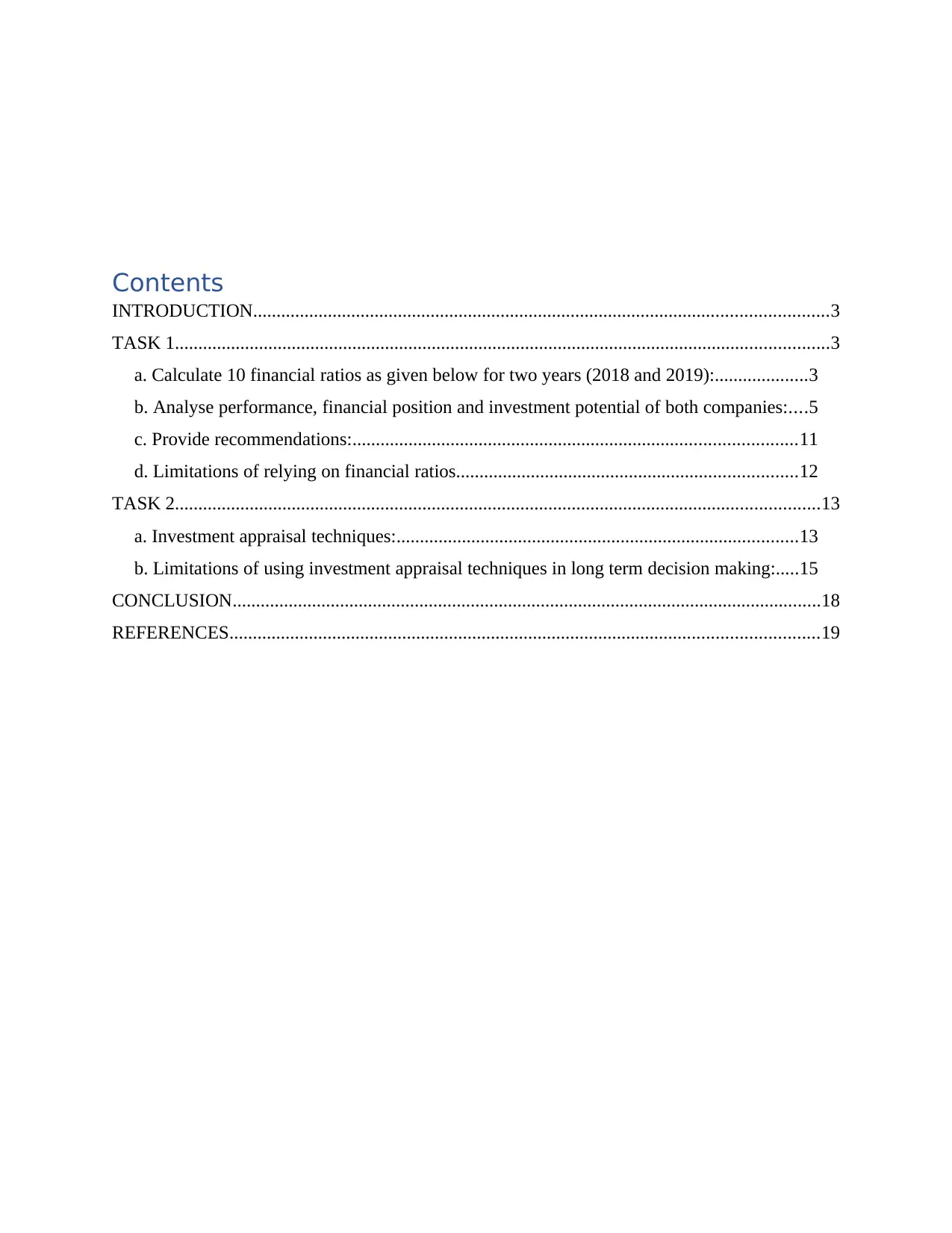
Contents
INTRODUCTION...........................................................................................................................3
TASK 1............................................................................................................................................3
a. Calculate 10 financial ratios as given below for two years (2018 and 2019):....................3
b. Analyse performance, financial position and investment potential of both companies:....5
c. Provide recommendations:...............................................................................................11
d. Limitations of relying on financial ratios.........................................................................12
TASK 2..........................................................................................................................................13
a. Investment appraisal techniques:......................................................................................13
b. Limitations of using investment appraisal techniques in long term decision making:.....15
CONCLUSION..............................................................................................................................18
REFERENCES..............................................................................................................................19
INTRODUCTION...........................................................................................................................3
TASK 1............................................................................................................................................3
a. Calculate 10 financial ratios as given below for two years (2018 and 2019):....................3
b. Analyse performance, financial position and investment potential of both companies:....5
c. Provide recommendations:...............................................................................................11
d. Limitations of relying on financial ratios.........................................................................12
TASK 2..........................................................................................................................................13
a. Investment appraisal techniques:......................................................................................13
b. Limitations of using investment appraisal techniques in long term decision making:.....15
CONCLUSION..............................................................................................................................18
REFERENCES..............................................................................................................................19
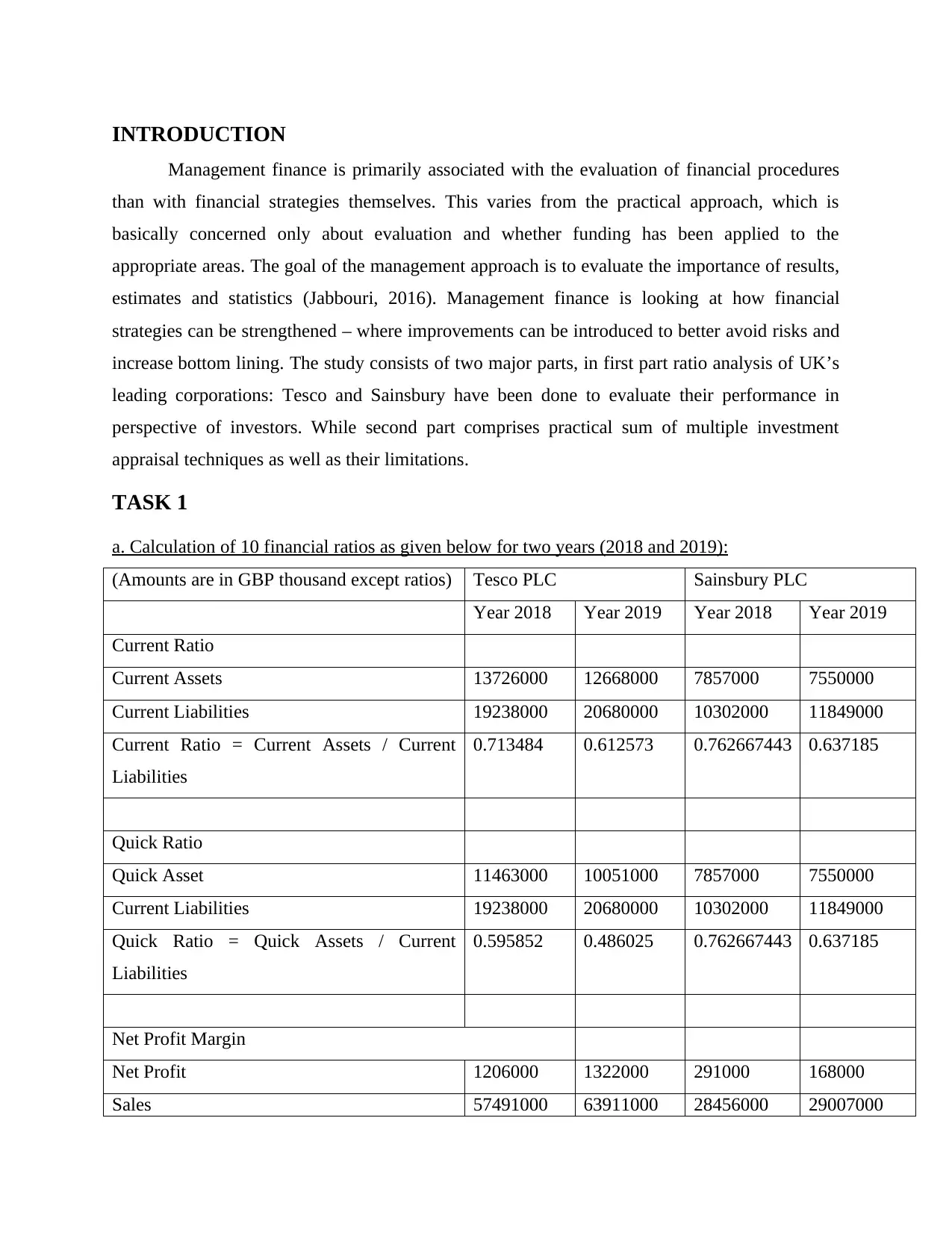
INTRODUCTION
Management finance is primarily associated with the evaluation of financial procedures
than with financial strategies themselves. This varies from the practical approach, which is
basically concerned only about evaluation and whether funding has been applied to the
appropriate areas. The goal of the management approach is to evaluate the importance of results,
estimates and statistics (Jabbouri, 2016). Management finance is looking at how financial
strategies can be strengthened – where improvements can be introduced to better avoid risks and
increase bottom lining. The study consists of two major parts, in first part ratio analysis of UK’s
leading corporations: Tesco and Sainsbury have been done to evaluate their performance in
perspective of investors. While second part comprises practical sum of multiple investment
appraisal techniques as well as their limitations.
TASK 1
a. Calculation of 10 financial ratios as given below for two years (2018 and 2019):
(Amounts are in GBP thousand except ratios) Tesco PLC Sainsbury PLC
Year 2018 Year 2019 Year 2018 Year 2019
Current Ratio
Current Assets 13726000 12668000 7857000 7550000
Current Liabilities 19238000 20680000 10302000 11849000
Current Ratio = Current Assets / Current
Liabilities
0.713484 0.612573 0.762667443 0.637185
Quick Ratio
Quick Asset 11463000 10051000 7857000 7550000
Current Liabilities 19238000 20680000 10302000 11849000
Quick Ratio = Quick Assets / Current
Liabilities
0.595852 0.486025 0.762667443 0.637185
Net Profit Margin
Net Profit 1206000 1322000 291000 168000
Sales 57491000 63911000 28456000 29007000
Management finance is primarily associated with the evaluation of financial procedures
than with financial strategies themselves. This varies from the practical approach, which is
basically concerned only about evaluation and whether funding has been applied to the
appropriate areas. The goal of the management approach is to evaluate the importance of results,
estimates and statistics (Jabbouri, 2016). Management finance is looking at how financial
strategies can be strengthened – where improvements can be introduced to better avoid risks and
increase bottom lining. The study consists of two major parts, in first part ratio analysis of UK’s
leading corporations: Tesco and Sainsbury have been done to evaluate their performance in
perspective of investors. While second part comprises practical sum of multiple investment
appraisal techniques as well as their limitations.
TASK 1
a. Calculation of 10 financial ratios as given below for two years (2018 and 2019):
(Amounts are in GBP thousand except ratios) Tesco PLC Sainsbury PLC
Year 2018 Year 2019 Year 2018 Year 2019
Current Ratio
Current Assets 13726000 12668000 7857000 7550000
Current Liabilities 19238000 20680000 10302000 11849000
Current Ratio = Current Assets / Current
Liabilities
0.713484 0.612573 0.762667443 0.637185
Quick Ratio
Quick Asset 11463000 10051000 7857000 7550000
Current Liabilities 19238000 20680000 10302000 11849000
Quick Ratio = Quick Assets / Current
Liabilities
0.595852 0.486025 0.762667443 0.637185
Net Profit Margin
Net Profit 1206000 1322000 291000 168000
Sales 57491000 63911000 28456000 29007000
⊘ This is a preview!⊘
Do you want full access?
Subscribe today to unlock all pages.

Trusted by 1+ million students worldwide
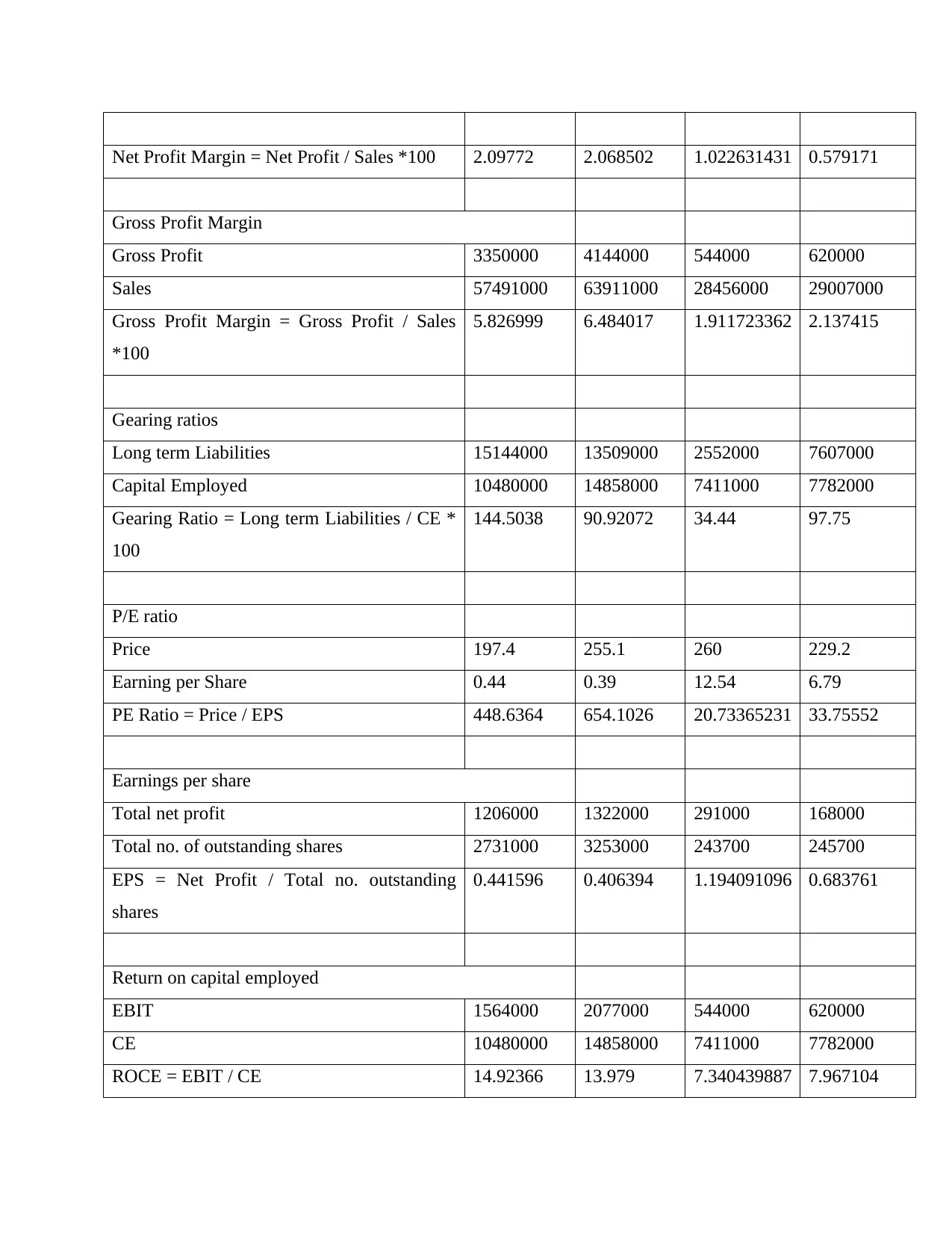
Net Profit Margin = Net Profit / Sales *100 2.09772 2.068502 1.022631431 0.579171
Gross Profit Margin
Gross Profit 3350000 4144000 544000 620000
Sales 57491000 63911000 28456000 29007000
Gross Profit Margin = Gross Profit / Sales
*100
5.826999 6.484017 1.911723362 2.137415
Gearing ratios
Long term Liabilities 15144000 13509000 2552000 7607000
Capital Employed 10480000 14858000 7411000 7782000
Gearing Ratio = Long term Liabilities / CE *
100
144.5038 90.92072 34.44 97.75
P/E ratio
Price 197.4 255.1 260 229.2
Earning per Share 0.44 0.39 12.54 6.79
PE Ratio = Price / EPS 448.6364 654.1026 20.73365231 33.75552
Earnings per share
Total net profit 1206000 1322000 291000 168000
Total no. of outstanding shares 2731000 3253000 243700 245700
EPS = Net Profit / Total no. outstanding
shares
0.441596 0.406394 1.194091096 0.683761
Return on capital employed
EBIT 1564000 2077000 544000 620000
CE 10480000 14858000 7411000 7782000
ROCE = EBIT / CE 14.92366 13.979 7.340439887 7.967104
Gross Profit Margin
Gross Profit 3350000 4144000 544000 620000
Sales 57491000 63911000 28456000 29007000
Gross Profit Margin = Gross Profit / Sales
*100
5.826999 6.484017 1.911723362 2.137415
Gearing ratios
Long term Liabilities 15144000 13509000 2552000 7607000
Capital Employed 10480000 14858000 7411000 7782000
Gearing Ratio = Long term Liabilities / CE *
100
144.5038 90.92072 34.44 97.75
P/E ratio
Price 197.4 255.1 260 229.2
Earning per Share 0.44 0.39 12.54 6.79
PE Ratio = Price / EPS 448.6364 654.1026 20.73365231 33.75552
Earnings per share
Total net profit 1206000 1322000 291000 168000
Total no. of outstanding shares 2731000 3253000 243700 245700
EPS = Net Profit / Total no. outstanding
shares
0.441596 0.406394 1.194091096 0.683761
Return on capital employed
EBIT 1564000 2077000 544000 620000
CE 10480000 14858000 7411000 7782000
ROCE = EBIT / CE 14.92366 13.979 7.340439887 7.967104
Paraphrase This Document
Need a fresh take? Get an instant paraphrase of this document with our AI Paraphraser
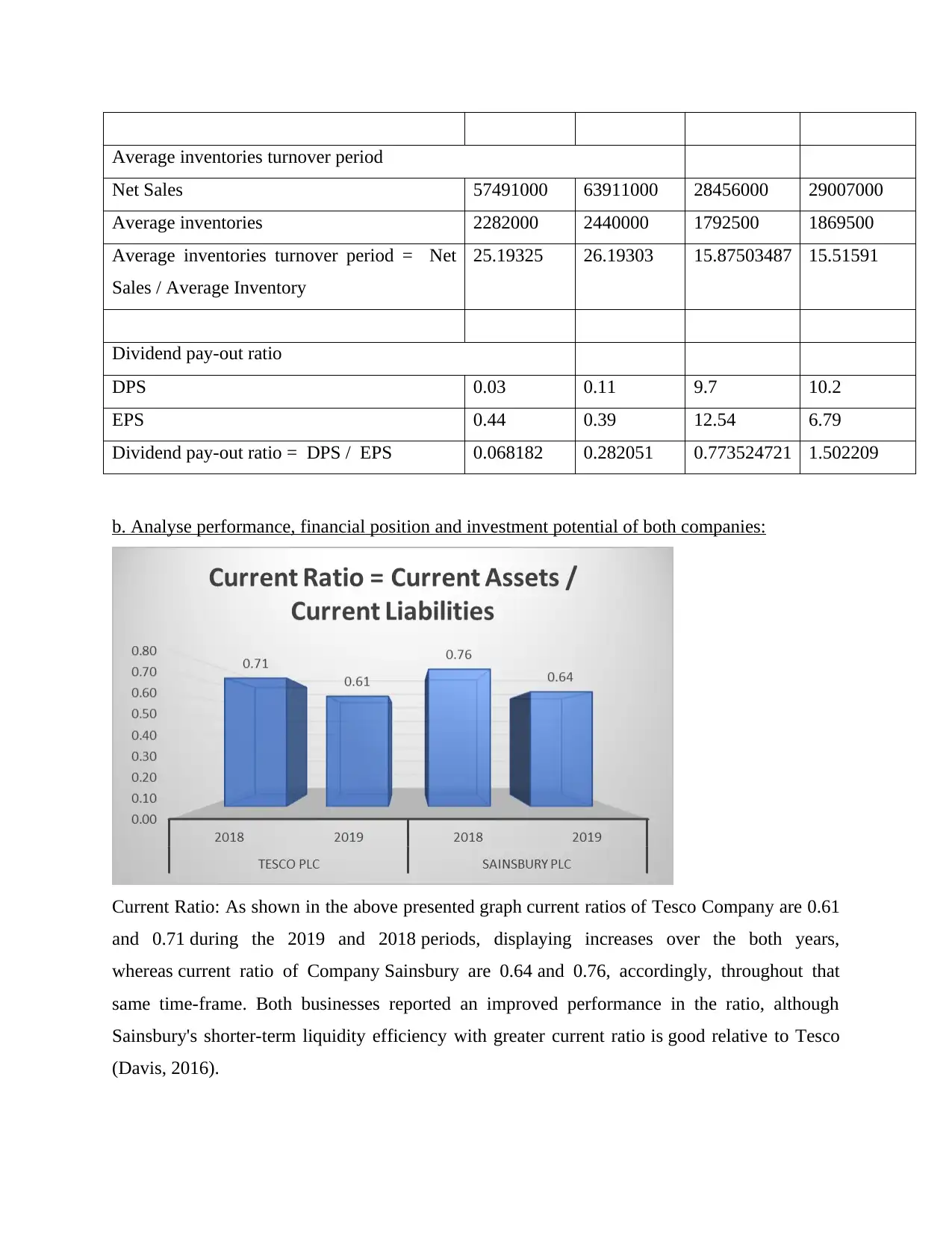
Average inventories turnover period
Net Sales 57491000 63911000 28456000 29007000
Average inventories 2282000 2440000 1792500 1869500
Average inventories turnover period = Net
Sales / Average Inventory
25.19325 26.19303 15.87503487 15.51591
Dividend pay-out ratio
DPS 0.03 0.11 9.7 10.2
EPS 0.44 0.39 12.54 6.79
Dividend pay-out ratio = DPS / EPS 0.068182 0.282051 0.773524721 1.502209
b. Analyse performance, financial position and investment potential of both companies:
Current Ratio: As shown in the above presented graph current ratios of Tesco Company are 0.61
and 0.71 during the 2019 and 2018 periods, displaying increases over the both years,
whereas current ratio of Company Sainsbury are 0.64 and 0.76, accordingly, throughout that
same time-frame. Both businesses reported an improved performance in the ratio, although
Sainsbury's shorter-term liquidity efficiency with greater current ratio is good relative to Tesco
(Davis, 2016).
Net Sales 57491000 63911000 28456000 29007000
Average inventories 2282000 2440000 1792500 1869500
Average inventories turnover period = Net
Sales / Average Inventory
25.19325 26.19303 15.87503487 15.51591
Dividend pay-out ratio
DPS 0.03 0.11 9.7 10.2
EPS 0.44 0.39 12.54 6.79
Dividend pay-out ratio = DPS / EPS 0.068182 0.282051 0.773524721 1.502209
b. Analyse performance, financial position and investment potential of both companies:
Current Ratio: As shown in the above presented graph current ratios of Tesco Company are 0.61
and 0.71 during the 2019 and 2018 periods, displaying increases over the both years,
whereas current ratio of Company Sainsbury are 0.64 and 0.76, accordingly, throughout that
same time-frame. Both businesses reported an improved performance in the ratio, although
Sainsbury's shorter-term liquidity efficiency with greater current ratio is good relative to Tesco
(Davis, 2016).
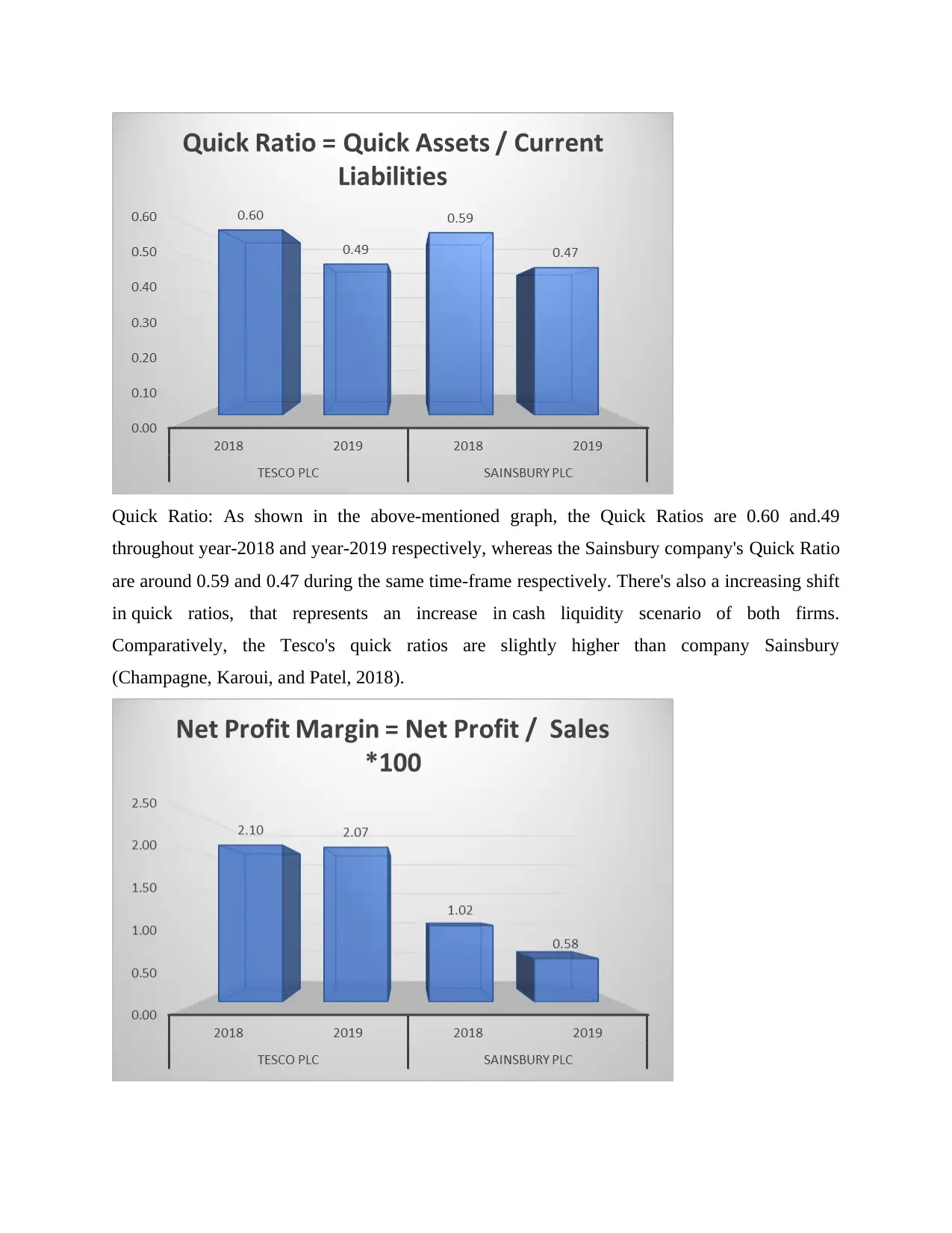
Quick Ratio: As shown in the above-mentioned graph, the Quick Ratios are 0.60 and.49
throughout year-2018 and year-2019 respectively, whereas the Sainsbury company's Quick Ratio
are around 0.59 and 0.47 during the same time-frame respectively. There's also a increasing shift
in quick ratios, that represents an increase in cash liquidity scenario of both firms.
Comparatively, the Tesco's quick ratios are slightly higher than company Sainsbury
(Champagne, Karoui, and Patel, 2018).
throughout year-2018 and year-2019 respectively, whereas the Sainsbury company's Quick Ratio
are around 0.59 and 0.47 during the same time-frame respectively. There's also a increasing shift
in quick ratios, that represents an increase in cash liquidity scenario of both firms.
Comparatively, the Tesco's quick ratios are slightly higher than company Sainsbury
(Champagne, Karoui, and Patel, 2018).
⊘ This is a preview!⊘
Do you want full access?
Subscribe today to unlock all pages.

Trusted by 1+ million students worldwide
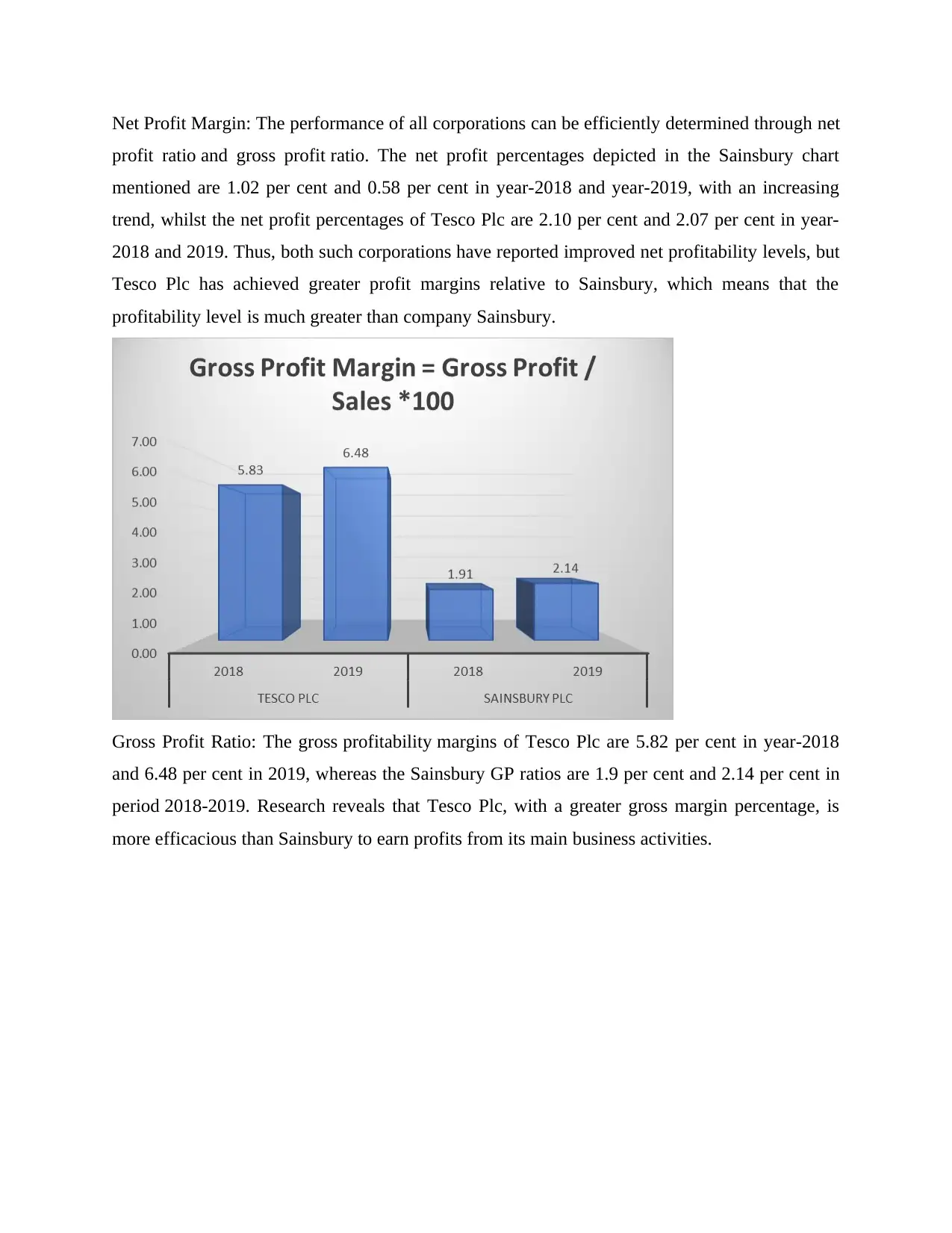
Net Profit Margin: The performance of all corporations can be efficiently determined through net
profit ratio and gross profit ratio. The net profit percentages depicted in the Sainsbury chart
mentioned are 1.02 per cent and 0.58 per cent in year-2018 and year-2019, with an increasing
trend, whilst the net profit percentages of Tesco Plc are 2.10 per cent and 2.07 per cent in year-
2018 and 2019. Thus, both such corporations have reported improved net profitability levels, but
Tesco Plc has achieved greater profit margins relative to Sainsbury, which means that the
profitability level is much greater than company Sainsbury.
Gross Profit Ratio: The gross profitability margins of Tesco Plc are 5.82 per cent in year-2018
and 6.48 per cent in 2019, whereas the Sainsbury GP ratios are 1.9 per cent and 2.14 per cent in
period 2018-2019. Research reveals that Tesco Plc, with a greater gross margin percentage, is
more efficacious than Sainsbury to earn profits from its main business activities.
profit ratio and gross profit ratio. The net profit percentages depicted in the Sainsbury chart
mentioned are 1.02 per cent and 0.58 per cent in year-2018 and year-2019, with an increasing
trend, whilst the net profit percentages of Tesco Plc are 2.10 per cent and 2.07 per cent in year-
2018 and 2019. Thus, both such corporations have reported improved net profitability levels, but
Tesco Plc has achieved greater profit margins relative to Sainsbury, which means that the
profitability level is much greater than company Sainsbury.
Gross Profit Ratio: The gross profitability margins of Tesco Plc are 5.82 per cent in year-2018
and 6.48 per cent in 2019, whereas the Sainsbury GP ratios are 1.9 per cent and 2.14 per cent in
period 2018-2019. Research reveals that Tesco Plc, with a greater gross margin percentage, is
more efficacious than Sainsbury to earn profits from its main business activities.
Paraphrase This Document
Need a fresh take? Get an instant paraphrase of this document with our AI Paraphraser
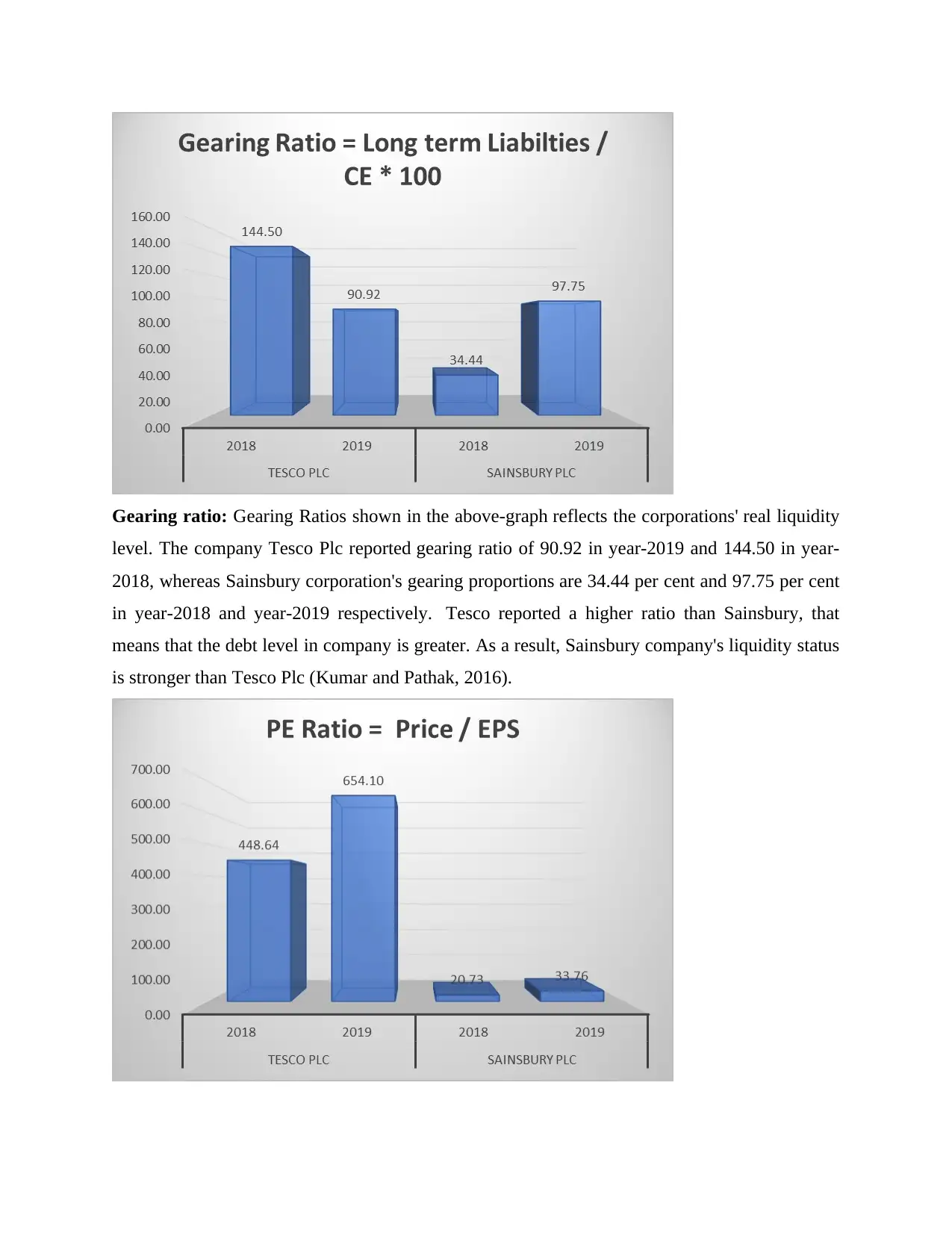
Gearing ratio: Gearing Ratios shown in the above-graph reflects the corporations' real liquidity
level. The company Tesco Plc reported gearing ratio of 90.92 in year-2019 and 144.50 in year-
2018, whereas Sainsbury corporation's gearing proportions are 34.44 per cent and 97.75 per cent
in year-2018 and year-2019 respectively. Tesco reported a higher ratio than Sainsbury, that
means that the debt level in company is greater. As a result, Sainsbury company's liquidity status
is stronger than Tesco Plc (Kumar and Pathak, 2016).
level. The company Tesco Plc reported gearing ratio of 90.92 in year-2019 and 144.50 in year-
2018, whereas Sainsbury corporation's gearing proportions are 34.44 per cent and 97.75 per cent
in year-2018 and year-2019 respectively. Tesco reported a higher ratio than Sainsbury, that
means that the debt level in company is greater. As a result, Sainsbury company's liquidity status
is stronger than Tesco Plc (Kumar and Pathak, 2016).
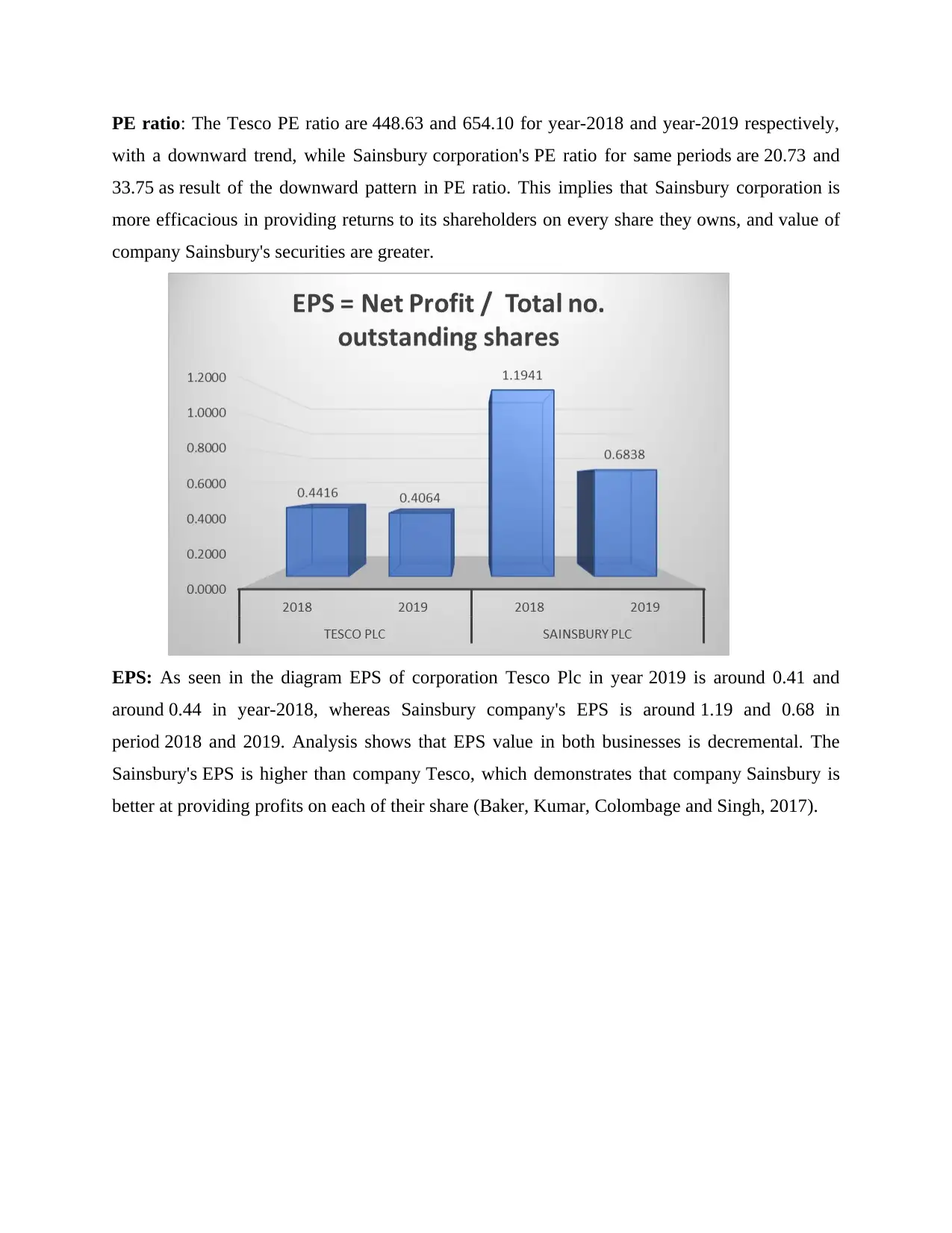
PE ratio: The Tesco PE ratio are 448.63 and 654.10 for year-2018 and year-2019 respectively,
with a downward trend, while Sainsbury corporation's PE ratio for same periods are 20.73 and
33.75 as result of the downward pattern in PE ratio. This implies that Sainsbury corporation is
more efficacious in providing returns to its shareholders on every share they owns, and value of
company Sainsbury's securities are greater.
EPS: As seen in the diagram EPS of corporation Tesco Plc in year 2019 is around 0.41 and
around 0.44 in year-2018, whereas Sainsbury company's EPS is around 1.19 and 0.68 in
period 2018 and 2019. Analysis shows that EPS value in both businesses is decremental. The
Sainsbury's EPS is higher than company Tesco, which demonstrates that company Sainsbury is
better at providing profits on each of their share (Baker, Kumar, Colombage and Singh, 2017).
with a downward trend, while Sainsbury corporation's PE ratio for same periods are 20.73 and
33.75 as result of the downward pattern in PE ratio. This implies that Sainsbury corporation is
more efficacious in providing returns to its shareholders on every share they owns, and value of
company Sainsbury's securities are greater.
EPS: As seen in the diagram EPS of corporation Tesco Plc in year 2019 is around 0.41 and
around 0.44 in year-2018, whereas Sainsbury company's EPS is around 1.19 and 0.68 in
period 2018 and 2019. Analysis shows that EPS value in both businesses is decremental. The
Sainsbury's EPS is higher than company Tesco, which demonstrates that company Sainsbury is
better at providing profits on each of their share (Baker, Kumar, Colombage and Singh, 2017).
⊘ This is a preview!⊘
Do you want full access?
Subscribe today to unlock all pages.

Trusted by 1+ million students worldwide
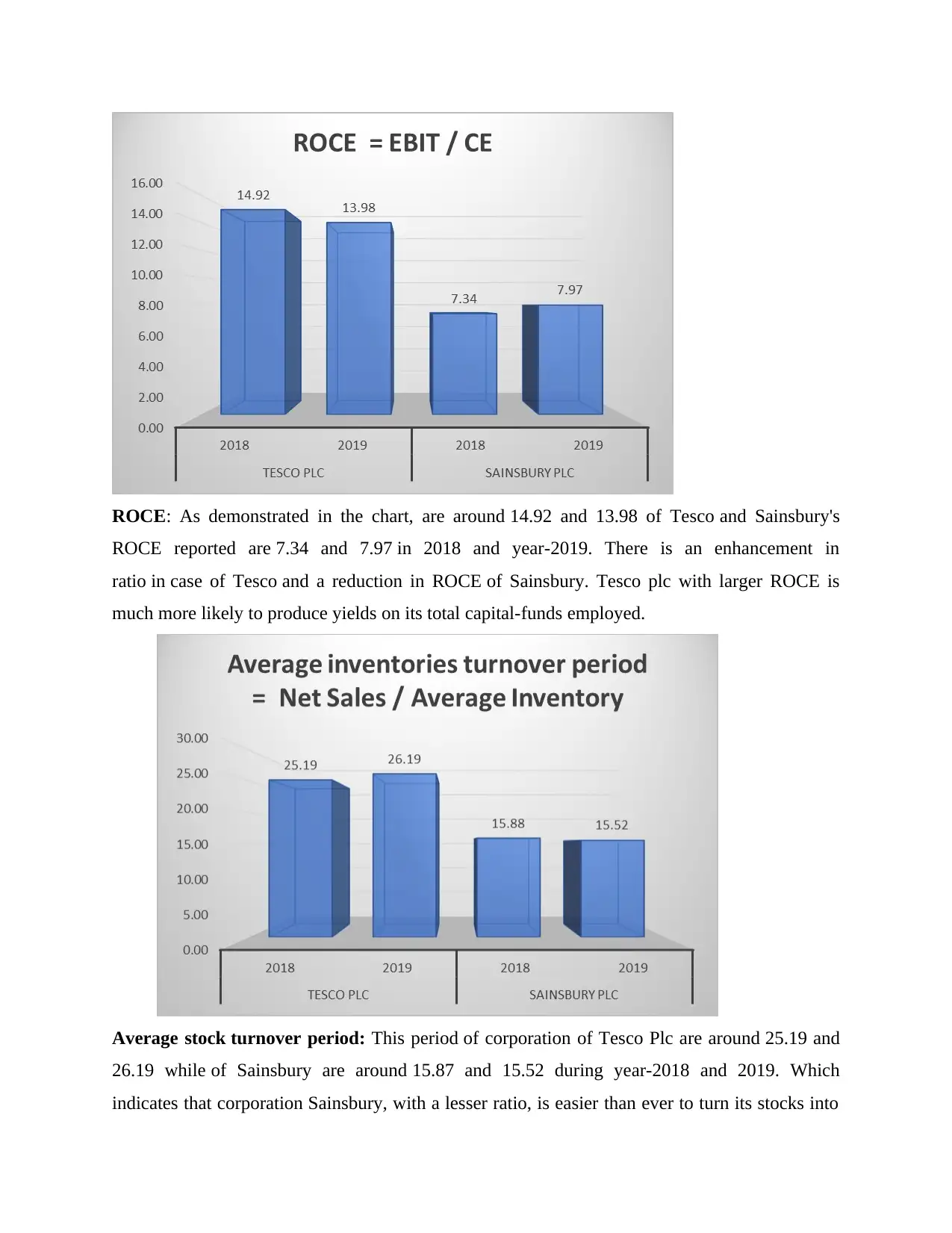
ROCE: As demonstrated in the chart, are around 14.92 and 13.98 of Tesco and Sainsbury's
ROCE reported are 7.34 and 7.97 in 2018 and year-2019. There is an enhancement in
ratio in case of Tesco and a reduction in ROCE of Sainsbury. Tesco plc with larger ROCE is
much more likely to produce yields on its total capital-funds employed.
Average stock turnover period: This period of corporation of Tesco Plc are around 25.19 and
26.19 while of Sainsbury are around 15.87 and 15.52 during year-2018 and 2019. Which
indicates that corporation Sainsbury, with a lesser ratio, is easier than ever to turn its stocks into
ROCE reported are 7.34 and 7.97 in 2018 and year-2019. There is an enhancement in
ratio in case of Tesco and a reduction in ROCE of Sainsbury. Tesco plc with larger ROCE is
much more likely to produce yields on its total capital-funds employed.
Average stock turnover period: This period of corporation of Tesco Plc are around 25.19 and
26.19 while of Sainsbury are around 15.87 and 15.52 during year-2018 and 2019. Which
indicates that corporation Sainsbury, with a lesser ratio, is easier than ever to turn its stocks into
Paraphrase This Document
Need a fresh take? Get an instant paraphrase of this document with our AI Paraphraser
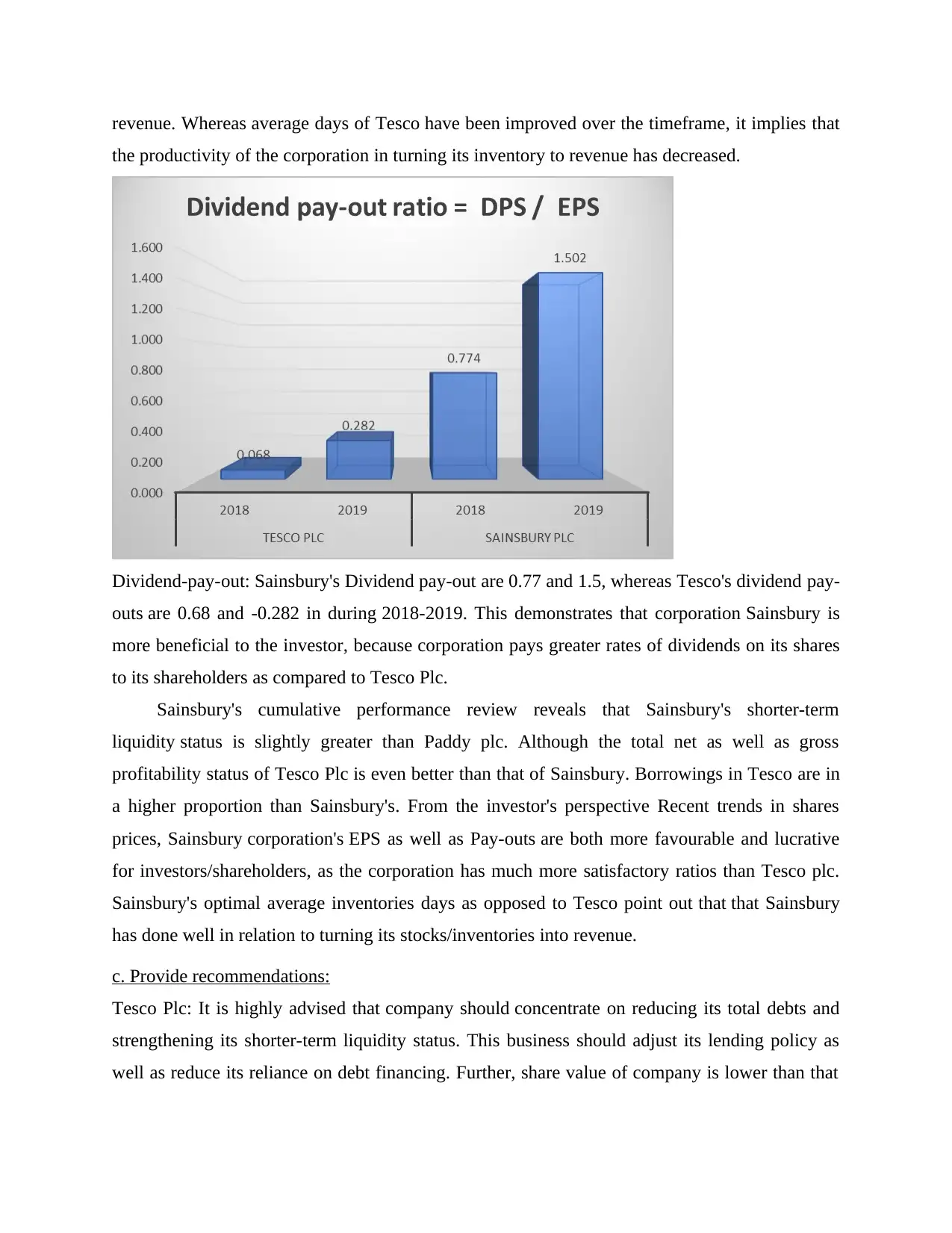
revenue. Whereas average days of Tesco have been improved over the timeframe, it implies that
the productivity of the corporation in turning its inventory to revenue has decreased.
Dividend-pay-out: Sainsbury's Dividend pay-out are 0.77 and 1.5, whereas Tesco's dividend pay-
outs are 0.68 and -0.282 in during 2018-2019. This demonstrates that corporation Sainsbury is
more beneficial to the investor, because corporation pays greater rates of dividends on its shares
to its shareholders as compared to Tesco Plc.
Sainsbury's cumulative performance review reveals that Sainsbury's shorter-term
liquidity status is slightly greater than Paddy plc. Although the total net as well as gross
profitability status of Tesco Plc is even better than that of Sainsbury. Borrowings in Tesco are in
a higher proportion than Sainsbury's. From the investor's perspective Recent trends in shares
prices, Sainsbury corporation's EPS as well as Pay-outs are both more favourable and lucrative
for investors/shareholders, as the corporation has much more satisfactory ratios than Tesco plc.
Sainsbury's optimal average inventories days as opposed to Tesco point out that that Sainsbury
has done well in relation to turning its stocks/inventories into revenue.
c. Provide recommendations:
Tesco Plc: It is highly advised that company should concentrate on reducing its total debts and
strengthening its shorter-term liquidity status. This business should adjust its lending policy as
well as reduce its reliance on debt financing. Further, share value of company is lower than that
the productivity of the corporation in turning its inventory to revenue has decreased.
Dividend-pay-out: Sainsbury's Dividend pay-out are 0.77 and 1.5, whereas Tesco's dividend pay-
outs are 0.68 and -0.282 in during 2018-2019. This demonstrates that corporation Sainsbury is
more beneficial to the investor, because corporation pays greater rates of dividends on its shares
to its shareholders as compared to Tesco Plc.
Sainsbury's cumulative performance review reveals that Sainsbury's shorter-term
liquidity status is slightly greater than Paddy plc. Although the total net as well as gross
profitability status of Tesco Plc is even better than that of Sainsbury. Borrowings in Tesco are in
a higher proportion than Sainsbury's. From the investor's perspective Recent trends in shares
prices, Sainsbury corporation's EPS as well as Pay-outs are both more favourable and lucrative
for investors/shareholders, as the corporation has much more satisfactory ratios than Tesco plc.
Sainsbury's optimal average inventories days as opposed to Tesco point out that that Sainsbury
has done well in relation to turning its stocks/inventories into revenue.
c. Provide recommendations:
Tesco Plc: It is highly advised that company should concentrate on reducing its total debts and
strengthening its shorter-term liquidity status. This business should adjust its lending policy as
well as reduce its reliance on debt financing. Further, share value of company is lower than that
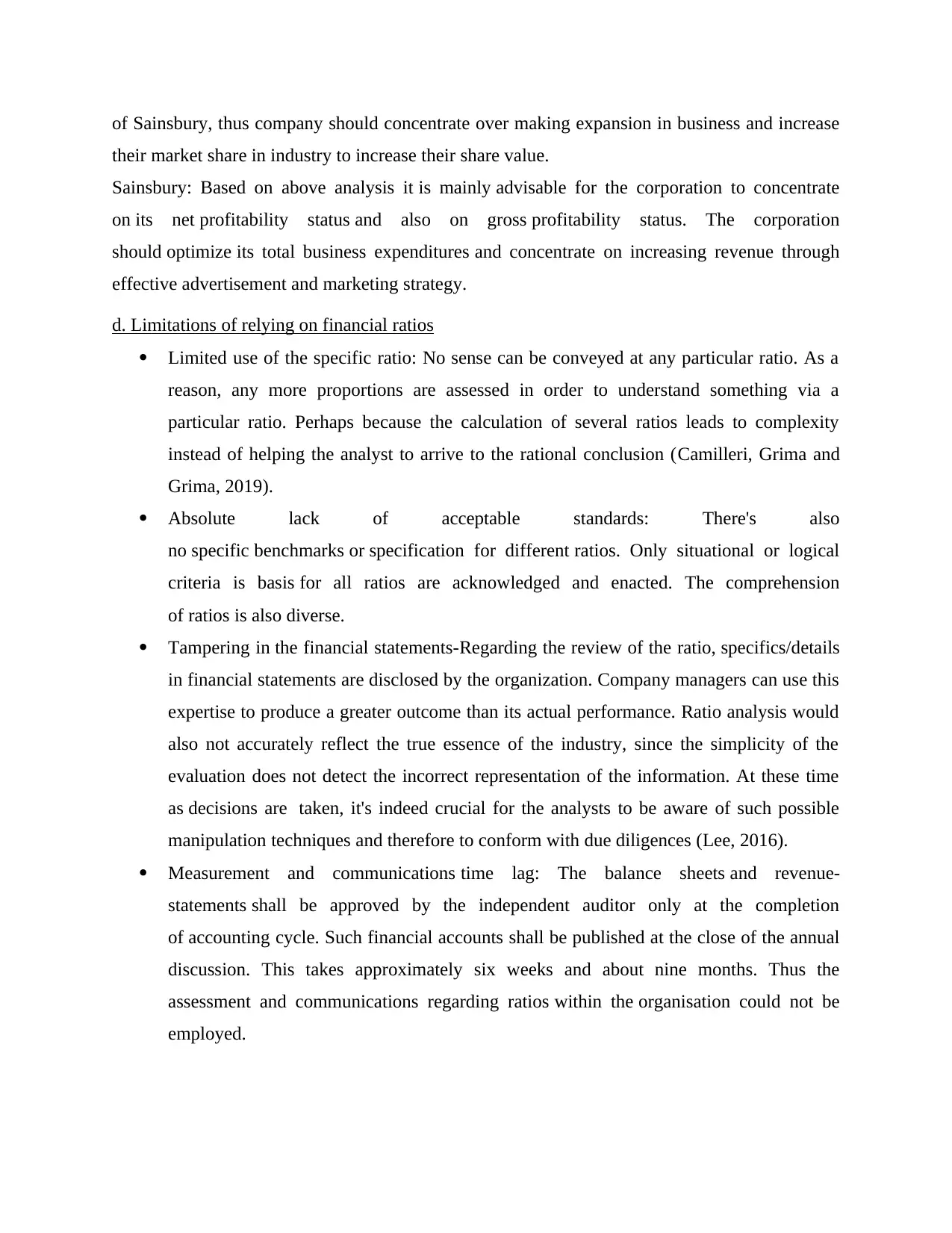
of Sainsbury, thus company should concentrate over making expansion in business and increase
their market share in industry to increase their share value.
Sainsbury: Based on above analysis it is mainly advisable for the corporation to concentrate
on its net profitability status and also on gross profitability status. The corporation
should optimize its total business expenditures and concentrate on increasing revenue through
effective advertisement and marketing strategy.
d. Limitations of relying on financial ratios
Limited use of the specific ratio: No sense can be conveyed at any particular ratio. As a
reason, any more proportions are assessed in order to understand something via a
particular ratio. Perhaps because the calculation of several ratios leads to complexity
instead of helping the analyst to arrive to the rational conclusion (Camilleri, Grima and
Grima, 2019).
Absolute lack of acceptable standards: There's also
no specific benchmarks or specification for different ratios. Only situational or logical
criteria is basis for all ratios are acknowledged and enacted. The comprehension
of ratios is also diverse.
Tampering in the financial statements-Regarding the review of the ratio, specifics/details
in financial statements are disclosed by the organization. Company managers can use this
expertise to produce a greater outcome than its actual performance. Ratio analysis would
also not accurately reflect the true essence of the industry, since the simplicity of the
evaluation does not detect the incorrect representation of the information. At these time
as decisions are taken, it's indeed crucial for the analysts to be aware of such possible
manipulation techniques and therefore to conform with due diligences (Lee, 2016).
Measurement and communications time lag: The balance sheets and revenue-
statements shall be approved by the independent auditor only at the completion
of accounting cycle. Such financial accounts shall be published at the close of the annual
discussion. This takes approximately six weeks and about nine months. Thus the
assessment and communications regarding ratios within the organisation could not be
employed.
their market share in industry to increase their share value.
Sainsbury: Based on above analysis it is mainly advisable for the corporation to concentrate
on its net profitability status and also on gross profitability status. The corporation
should optimize its total business expenditures and concentrate on increasing revenue through
effective advertisement and marketing strategy.
d. Limitations of relying on financial ratios
Limited use of the specific ratio: No sense can be conveyed at any particular ratio. As a
reason, any more proportions are assessed in order to understand something via a
particular ratio. Perhaps because the calculation of several ratios leads to complexity
instead of helping the analyst to arrive to the rational conclusion (Camilleri, Grima and
Grima, 2019).
Absolute lack of acceptable standards: There's also
no specific benchmarks or specification for different ratios. Only situational or logical
criteria is basis for all ratios are acknowledged and enacted. The comprehension
of ratios is also diverse.
Tampering in the financial statements-Regarding the review of the ratio, specifics/details
in financial statements are disclosed by the organization. Company managers can use this
expertise to produce a greater outcome than its actual performance. Ratio analysis would
also not accurately reflect the true essence of the industry, since the simplicity of the
evaluation does not detect the incorrect representation of the information. At these time
as decisions are taken, it's indeed crucial for the analysts to be aware of such possible
manipulation techniques and therefore to conform with due diligences (Lee, 2016).
Measurement and communications time lag: The balance sheets and revenue-
statements shall be approved by the independent auditor only at the completion
of accounting cycle. Such financial accounts shall be published at the close of the annual
discussion. This takes approximately six weeks and about nine months. Thus the
assessment and communications regarding ratios within the organisation could not be
employed.
⊘ This is a preview!⊘
Do you want full access?
Subscribe today to unlock all pages.

Trusted by 1+ million students worldwide
1 out of 19
Related Documents
Your All-in-One AI-Powered Toolkit for Academic Success.
+13062052269
info@desklib.com
Available 24*7 on WhatsApp / Email
![[object Object]](/_next/static/media/star-bottom.7253800d.svg)
Unlock your academic potential
Copyright © 2020–2025 A2Z Services. All Rights Reserved. Developed and managed by ZUCOL.





